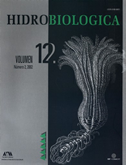Biochemical characterization of crude extract from Pleuroncodes planipes (Crustacea: Galatheidae) as potential feed additive, considerations for a new fishery along the Mexico Pacific coast
Palabras clave:
Pleuroncodes planipes, red crab, nutrition, crustacean, Mexican fisheryResumen
The red crab Pleuroncodes planipes, commonly called "langostilla" is arguably the most abundant benthonic decapod of west coast Mexico, with natural productivity estimated at 735,000 metric tons/year. At the present time, it has not been exploited commercially. The implementation of a new fishery in Mexico, based on the capture of red carb, offers diversification of the fishing industry. In this work, a raw extract of langostilla, obtained by mechanical pressing of the whole organism, was analyzed as a potential feed ingredient or additive for cultured marine species. The lyophilized red crab extracts possessed: 1) enzymatic activity of protease, trypsin, amylase, and lipase; 2) no inhibition of serine-proteases; 3) antioxidant capacity against lipoperoxidation and superoxide ions produced by xanthine oxidase reaction; and 4) activity of insulin-like peptides. The amino acid profile shows high levels of arginine, lysine, and methionine. The cheical score of extract protein was compared with M. japonicus larvae, whole body fish tissue, and short-necked clam tissue. The digestibility of the product was 95% taking purified casein as reference. These biochemical and nutritional characteristics are discussed. These results offer a new use of red crab and the potential of a new fishery in Mexico.Descargas
Descargas
Cómo citar
Número
Sección
Licencia
Los autores/as que publiquen en esta revista aceptan las siguientes condiciones:
De acuerdo con la legislación de derechos de autor, HIDROBIOLÓGICA reconoce y respeta el derecho moral de los autores, así como la titularidad del derecho patrimonial, el cual será cedido a la revista para su difusión en acceso abierto.
Publicar en la revista HIDROBIOLÓGICA tiene un costo de recuperación de $500 pesos mexicanos por página en blanco y negro (aproximadamente 29 dólares americanos) y $1000 pesos por página a color (aproximadamente 58 dólares americanos).
Todos los textos publicados por HIDROBIOLÓGICA sin excepción se distribuyen amparados bajo la licencia Creative Commons 4.0Atribución-No Comercial (CC BY-NC 4.0 Internacional), que permite a terceros utilizar lo publicado siempre que mencionen la autoría del trabajo y a la primera publicación en esta revista.
Los autores/as pueden realizar otros acuerdos contractuales independientes y adicionales para la distribución no exclusiva de la versión del artículo publicado en HIDROBIOLÓGICA (por ejemplo incluirlo en un repositorio institucional o publicarlo en un libro) siempre que indiquen claramente que el trabajo se publicó por primera vez en HIDROBIOLÓGICA.
Para todo lo anterior, el o los autor(es) deben remitir el formato de Carta-Cesión de la Propiedad de los Derechos de la primera publicación debidamente requisitado y firmado por el autor(es). Este formato se puede enviar por correo electrónico en archivo pdf al correo: enlacerebvistahidrobiológica@gmail.com; rehb@xanum.uam.mx (Carta-Cesión de Propiedad de Derechos de Autor).
Esta obra está bajo una licencia de Creative Commons Reconocimiento-No Comercial 4.0 Internacional.


